市场资讯及洞察
%20(1).jpg)
Pine Script是TradingView提供的专属编程语言,旨在帮助交易者创建自定义指标和策略,进行回测和实时分析。作为一种轻量级但功能强大的语言,Pine Script 使用户能够在TradingView平台上实现个性化的技术分析工具。要在TradingView上使用Pine Script,首先需要在图表界面打开“Pine 编辑器”。在编辑器中,用户可以编写脚本并将其应用于图表。脚本可以是指标(如移动平均线、RSI 等)或策略(用于回测交易信号)。
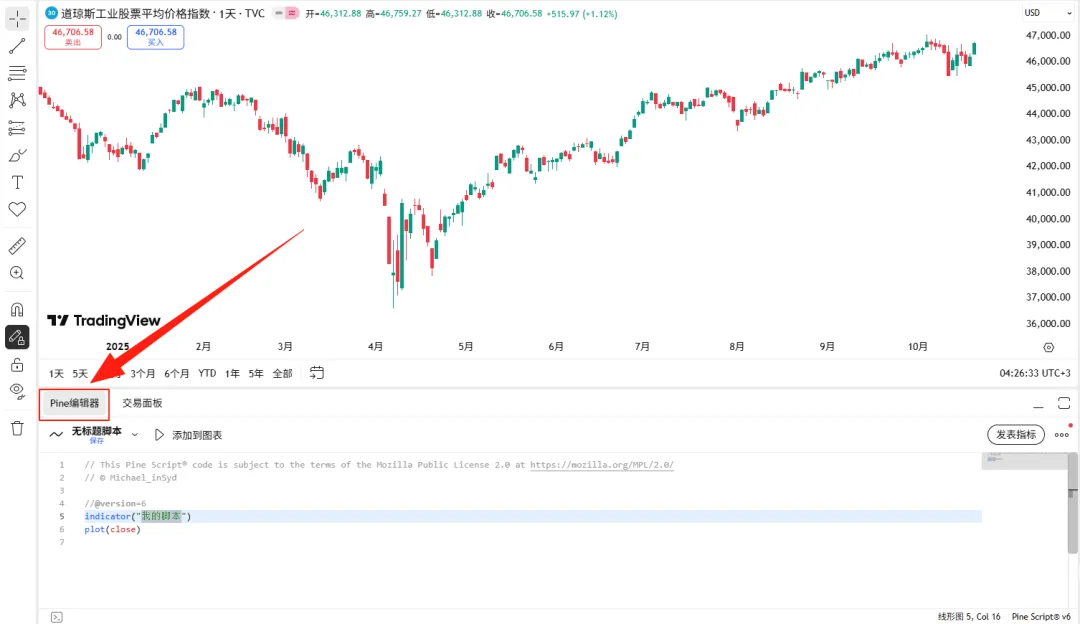
官方文档提供了详细的函数和示例,帮助用户理解和应用各种功能。此外,TradingView拥有一个活跃的社区,用户可以在“公共库”中浏览和使用他人分享的脚本。通过搜索功能,可以找到各种类型的指标和策略,满足不同的交易需求。许多脚本是开源的,用户可以查看其源代码,学习他人的编程思路,并根据自己的需要进行修改和优化。介绍完 Pine Script 的基础功能后,接下来我们将动手实战,编写第一个简单的均线技术指标,并将其应用到K线图中。
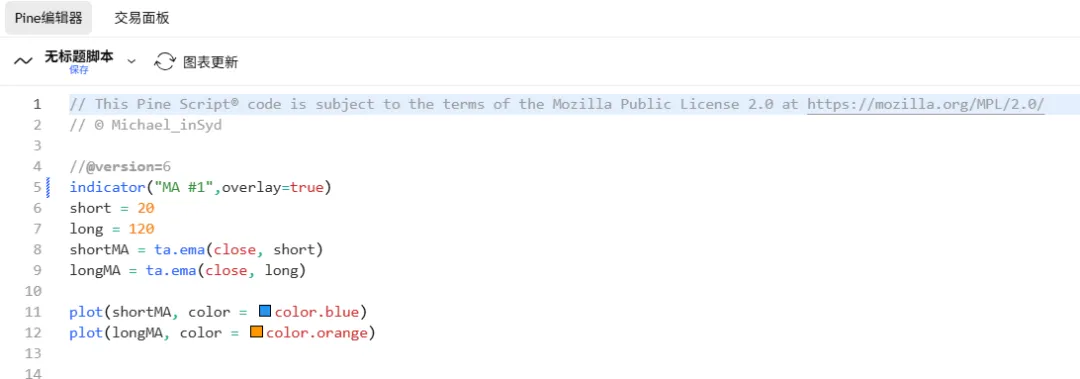
indicator("MA #1",overlay=true)short = 20long = 120shortMA = ta.ema(close, short)longMA = ta.ema(close, long)plot(shortMA, color = color.blue)plot(longMA, color = color.orange)这段Pine Script脚本实现了在TradingView的主图(也就是 K 线图)上绘制两条不同周期的指数移动平均线(EMA)。它的作用是帮助交易者观察市场的短期与长期趋势,是很多技术分析中常见的基础工具。首先,脚本通过indicator("MA #1", overlay=true)定义了指标的基本信息。其中"MA #1"是该指标在图表上显示的名称,而overlay=true表示该指标将直接绘制在价格图上,而不是在单独的副图中显示。接下来,脚本定义了两个变量short=20和long=120,分别代表短期和长期均线的周期。周期指的是计算均线时所参考的历史K线数量,比如在日线图中,20就代表20个交易日。之后,使用ta.ema(close, short)和ta.ema(close, long)计算出这两个周期的EMA值,分别赋值给shortMA 和longMA。EMA是一种常用的平滑移动平均方式,相较于简单移动平均(SMA),它对最新的数据更敏感,因此在趋势判断上更及时。最后,通过plot(shortMA, color=color.blue) 和 plot(longMA, color=color.orange) 将两条 EMA 线绘制到图表上,分别使用蓝色和橙色加以区分。这样,交易者在图表中就可以直观地看到短期与长期的价格趋势,有助于进行技术分析、识别趋势方向或寻找潜在的买卖点。

整体而言,这段代码是非常适合初学者的 Pine Script 示例,简洁清晰,同时具备实用性,为后续扩展更多交易逻辑(如信号提示、策略测试等)打下良好基础。
免责声明:GO Markets 分析师或外部发言人提供的信息基于其独立分析或个人经验。所表达的观点或交易风格仅代表其个人;并不代表 GO Markets 的观点或立场。
联系方式:
墨尔本 03 8658 0603
悉尼 02 9188 0418
中国地区(中文) 400 120 8537中国地区(英文) +248 4 671 903
作者:
Michael Miao | GO Markets 悉尼中文部


热门话题
11月20日盘后,英伟达(NVIDIA)发布了备受关注的2025财年第三季度财报。公司再次交出亮眼成绩单,营收和盈利均超市场预期。然而,尽管数据优异,这次市场反应却显得冷淡,收跌将近0.8%,但盘后股价一度下跌4%以上。那我们今天的文章就是来多角度看一下英伟达这次财报透露出的信息和这种现象发生的原因。
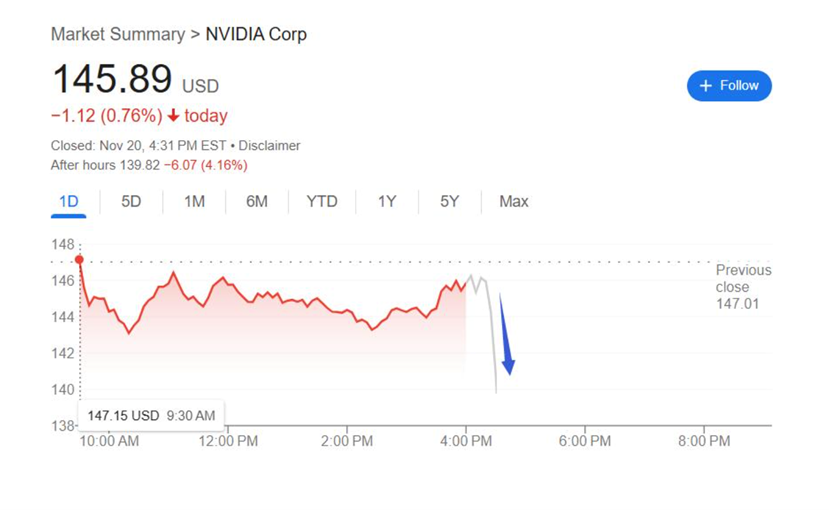
首先根据财报数据,英伟达第三季度营收达到351亿美元,同比增长17%,超出市场预期的347亿美元。净利润则同比激增至193.12亿美元,反映出其强大的盈利能力。数据中心业务成为增长主力,收入高达308亿美元,同比增长112%,这一表现再次巩固了英伟达在AI芯片市场的领导地位。游戏业务方面,营收达33亿美元,显示出稳定的市场需求。此外,英伟达的毛利率高达74.6%,刷新了历史记录,这得益于其高端AI芯片的定价策略和强劲需求。然而,公司也警告称,供应链瓶颈可能会在未来几个季度影响Hopper和Blackwell芯片的供应,这一消息的发出也导致市场对这次超出预期的财报并没有过于热情的反应。

所以我们看到英伟达的股价在盘后交易中下跌4%以上,这也反映出投资者的复杂情绪。那么我们认为以下几个因素可能导致这一反应:高估值的压力英伟达当前市值接近1万亿美元,其股价已经包含了市场对未来增长的高度预期。尽管Q3财报超预期,但与上一季度的爆发式增长相比,增速明显放缓,投资者担忧这种趋势可能成为常态。供应链隐忧英伟达在电话会议中提到,Blackwell芯片的出货将在2025财年第四季度开始,但供应链限制可能持续至2026年。这一消息增加了投资者对公司未来营收增长的不确定性。短期业绩压力尽管数据中心业务表现强劲,但市场对未来几个季度的增长路径表现出谨慎态度。部分分析师认为,市场已经透支了对英伟达短期增长的预期,投资者期待看到更多新的增长点。尽管这次盘后的反应并不强烈,但是在人工智能浪潮下,英伟达仍然是最大的受益者之一。公司Hopper和Blackwell系列芯片的强劲需求,以及AI技术在更多行业的应用扩展,为其未来增长提供了坚实基础,比如我们所熟知的花旗银行就上调了英伟达2025财年、2026财年和2027财年的EPS预期,并把目标股价从150美元上调至170美元。
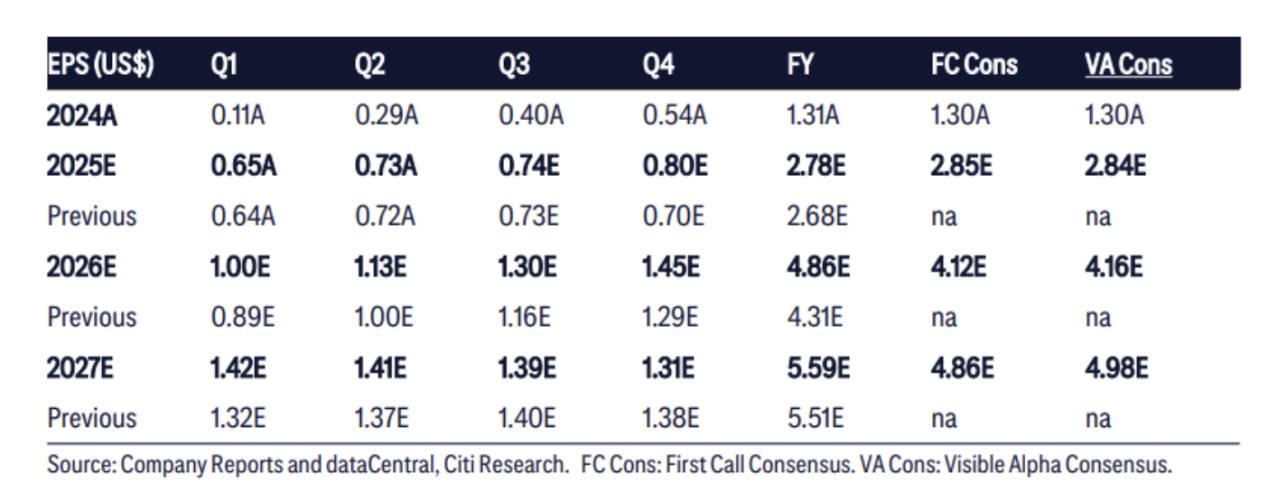
并且根据期权市场的数据我们会发现市场对英伟达财报的反应比对下月的非农、CPI和FOMC利率决议更为敏感,表明英伟达财报对市场(比如S&P500)的影响可能超过其他比较重大的经济事件了,这也表明英伟达的市场地位已经不容小觑。当然除此英伟达也在面临一些挑战:首先是面临的竞争压力,随着AMD、谷歌和亚马逊等巨头加速布局AI芯片市场,英伟达需要不断创新以维持其领先地位。此外,竞争对手在价格和性能上的追赶可能会对英伟达的市场份额和定价策略构成威胁。而放眼全球的宏观经济,全球经济增速放缓和高通胀可能压制企业对AI基础设施的投资,尤其是在利率高企的背景下。英伟达的增长依赖于数据中心和云计算领域的持续扩张,而宏观经济环境的不确定性可能对其增长产生拖累。以及我们前面提到过的供应链压力都可能在不同程度上影响英伟达未来的表现。

总体来说,这次英伟达的Q3财报再次证明了其在AI和芯片领域的强劲实力,但市场对其未来增长路径的期望已达极高水平,在高估值的背景下,短期的增速放缓和供应链隐忧成为压制股价的重要因素。未来,英伟达需要在技术创新、供应链优化和市场拓展方面继续发力才能保持行业领先地位。同时,投资者也是需要关注全球宏观经济环境、竞争格局变化以及AI技术的应用拓展,这些都将成为影响英伟达股价和增长的重要变量。当然了,我们还是认为无论是短期调整还是长期潜力,英伟达作为芯片界的领头老大,未来很长一段时间仍将是全球科技行业的风向标之一。免责声明:GO Markets 分析师或外部发言人提供的信息基于其独立分析或个人经验。所表达的观点或交易风格仅代表其个人;并不代表 GO Markets 的观点或立场。联系方式:墨尔本 03 8658 0603悉尼 02 9188 0418中国地区(中文) 400 120 8537中国地区(英文) +248 4 671 903作者:Yoyo Ma | GO Markets 墨尔本中文部


热门话题
在巴西二十国集团峰会期间举行的双边会晤中,澳洲总理阿尔巴尼斯和中国国家主席习近平讨论了两国关系的改善。为什么说近期是两国关系的转折点呢,核心是,特朗普重返白宫,承诺对所有进口到美国的商品征收高额关税,引发全球担忧。澳洲和中国在这个情况下,可能要加强双边贸易合作,将美国减少的市场份额,分配到其他国家和地区。如果我是澳洲总理,在特朗普上台的背景下,我会利用其贸易保护主义政策和全球经济格局的变化,推动澳大利亚实现更具战略性和多元化的国际贸易布局,同时在对中国态度和经济合作上采取灵活务实的策略。目前,总理阿尔巴尼斯宣布,和中国的“葡萄酒、木材、煤炭、大麦、海鲜等多个行业的贸易障碍已经消除,约 200 亿美元的贸易已经恢复。”

其实澳洲能做的,可以做的事情有很多,只要澳洲“公务员”稍微勤劳一些。当然,澳洲生活本来就是自由且缓慢的。但我们作为居民,仍然希望澳洲的经济能够更加繁荣。所以,借助特朗普全球战略收缩布局的背景,应该加强澳洲国际贸易领域的地位。首先扩大市场合作,减少对单一市场的依赖,包括对美国和中国部分领域的集中式出口或进口。最简单的就是加强与东南亚和南亚国家的合作,利用东盟的区域全面经济伙伴关系协定(RCEP),通过双边和多边贸易协议深化与东盟国家的合作。扩展与越南、泰国等制造业快速崛起国家的经贸关系,构建替代市场,降低未来输入性通胀的风险。借特朗普对欧洲盟友的疏远契机,与欧盟深化自由贸易协议(FTA)谈判,增加高附加值产品(如清洁能源技术和教育服务)的出口。在北美地区推动与加拿大和墨西哥的贸易合作,避免完全依赖美国市场。

其次,利用地缘优势,打造区域供应链枢纽。利用澳大利亚在印太地区的地理位置,主动融入全球供应链重组。澳洲到目前连个自己的汽车品牌都搞丢了,在制造业领域非常惨淡。但是中高端的供应链,可以加大国际人才和资本的吸引力度,鼓励国际企业在澳洲设立区域性物流、制造和数据中心,特别是在特朗普政策使供应链从中国转移的背景下。对中国方面,将中国作为战略贸易伙伴,但合作重点从资源出口转向高附加值领域。在清洁能源技术(如太阳能、电池存储技术)、农业科技和医疗设备方面寻求合作。鼓励中国对澳大利亚基建和高科技产业的投资,同时确保国家安全审查的透明性。大家想一想,如果澳洲几个城市,能够有高铁连起来,那么大家的出行,经济的发展,都会更进一步。当然,只是设想一下。在政策上,平衡中美关系,在对华政策上采取“不选边站”的态度。既通过与美国的盟友关系保护澳洲国家安全,又通过与中国的经济合作获取实惠。将中澳贸易争端诉诸世界贸易组织(WTO)等多边平台,避免双边摩擦升级。发展经济,藏富于民,增加人民收入和幸福指数,加强澳洲的综合实力,才是硬道理。在经济结构上,趁着美国回笼战略辐射范围的背景下,应该 推动国内经济转型,减少资源依赖:加大对高附加值产业(如人工智能、数字经济、农业科技)的支持,推动经济转型。加速清洁能源经济:发展澳洲丰富的太阳能、风能等清洁能源资源,将其出口至能源需求国(如日本、韩国)。建立出口多元化基金:为出口企业提供资金支持,帮助其开拓新兴市场。优化出口商服务:通过简化手续、税收优惠等措施,提升澳洲出口企业的国际竞争力。把美国放弃的合作,争取挖过来。填补美国退出的市场空白。

所以,总的来说,澳洲未来能够在经济领域,快速走出澳洲,用全球视野,做产业和经济结构转型和升级,引进国际人才和资本,输出本国特殊的经济产品,能够快速在国际社会上提升影响力,同时增加本土居民收入水平,降低单一合作伙伴或经济结构的潜在风险。金融领域,我认为中长期澳币还是要上涨,基于澳洲未来的经济机遇和大宗商品的推动,包括央行利率水平的稳定性,相比于特朗普,澳洲降息会滞后。同时,股票市场,目前情况下,BHP等矿业巨头股票,可能会在未来国际贸易中获益。大家可以关注中澳双边关系改善带来的贸易和投资机会。免责声明:GO Markets 分析师或外部发言人提供的信息基于其独立分析或个人经验。所表达的观点或交易风格仅代表其个人;并不代表 GO Markets 的观点或立场。联系方式:墨尔本 03 8658 0603悉尼 02 9188 0418中国地区(中文) 400 120 8537中国地区(英文) +248 4 671 903作者:Jacky Wang | GO Markets 亚洲投研部主管
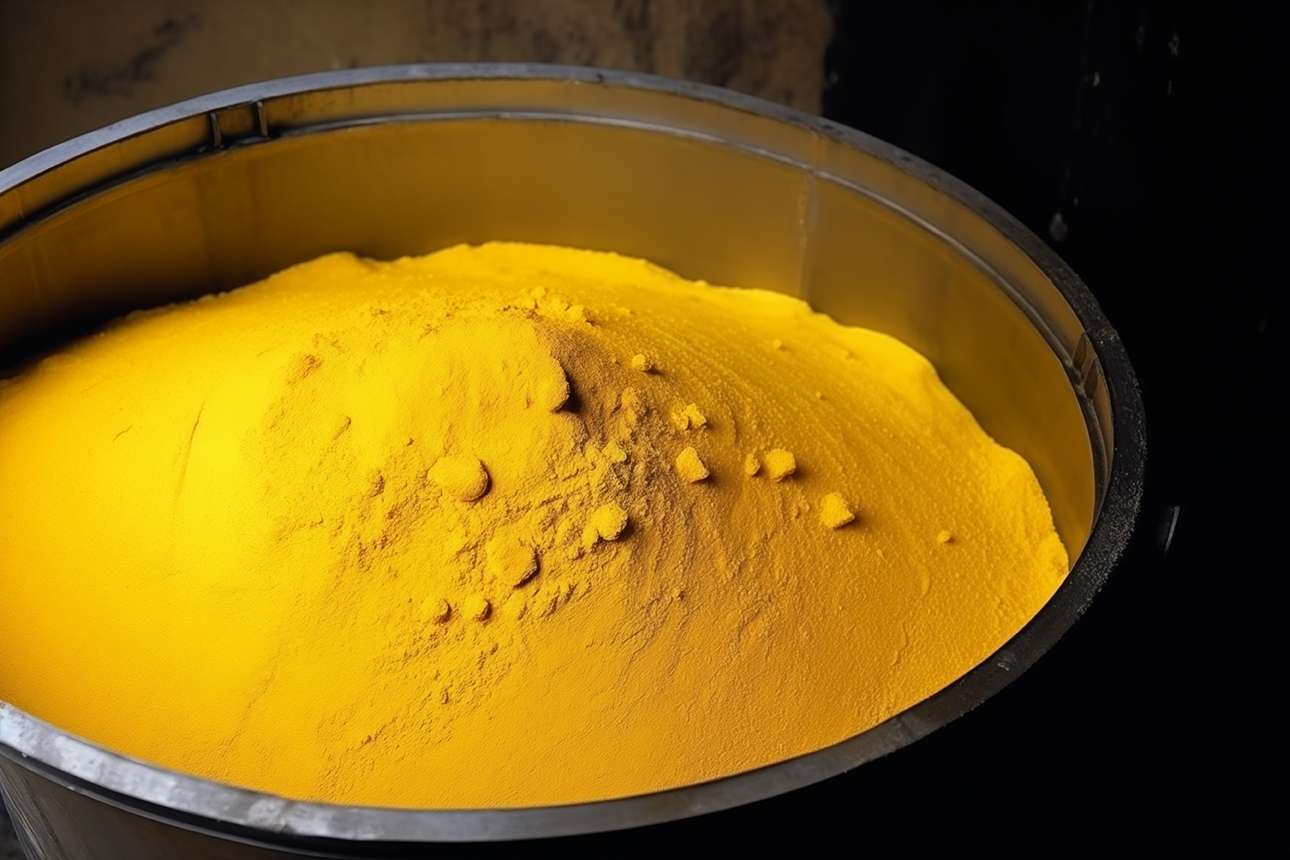

Yellowcake - a commodity that is loved and loathed all in the same breath. The questions we have been asking are - which is right and what’s the outlook? Because as traders and investors that dilemma is key, there is a gap here and that leads to volatility and incorrect pricing in the short and long term some may want to jump on.
Recent developments in the uranium market suggest we may be witnessing the beginning of a significant shift. After a prolonged period of downward pressure on prices, two key events over the past two weeks have kicked yellowcake back into the minds of traders. First is the geopolitical supply shock, the second are signals of increased long-term demand.
That is music to us in economics as this is a pure supply and demand thematic and suggests a potential reversal. Together, they could usher in a new phase of steady price appreciation, reminiscent of the market's bullish run in 2023. Point 1: Demand Side: U.S.
Energy Policy Could Lay the Foundation for Long-Term Growth The first major factor influencing uranium demand stems from the U.S. political landscape. The election of President-elect Donald Trump introduces a new energy agenda, one that could reshape the trajectory of nuclear power in the United States. While Trump's campaign rhetoric and early post-election messaging have heavily emphasised fossil fuel expansion - check last week’s piece on the "drill, baby, drill" thematic - it’s clear that nuclear power also holds a significant place in his vision for America’s energy future.
Trump has repeatedly voiced support for nuclear energy, particularly for small modular reactors (SMRs). These advanced nuclear technologies are seen as the next generation of clean energy solutions, offering modular, scalable power generation with enhanced safety and efficiency. In recent speeches and interviews, Trump has highlighted (in his view) nuclear energy is part of the solution needed in achieving sustainability, lower carbon emissions, and enhancing U.S. energy independence.
That last point is actually his biggest driver here being an America First ideal. This policy focus could mark a critical inflection point for uranium demand globally. While nuclear infrastructure projects are long-term endeavours and won’t generate immediate demand for uranium, the signals are clear: the U.S. government may soon prioritise nuclear energy investments in ways we haven’t seen in decades.
It also comes at a time when the likes of France and to some extent greater Europe moves in this direction. Either way as these plans materialise, uranium’s importance as a strategic resource will only grow. Moreover, Asia is also shifting its focus to this energy source as well.
Asian countries are increasing their reliance on nuclear energy to meet ambitious carbon neutrality targets. This international momentum could compound the effects of U.S. policy changes, creating a robust foundation for sustained uranium demand over the next decade. Point 2 Supply Side: Part 1 Russia’s Export Restrictions Tighten the Market The second major development is far more immediate and impactful.
That changes on the supply side of the equation. Last week, Russia announced new restrictions on the export of enriched uranium to the United States, escalating geopolitical tensions and significantly disrupting global supply chains. This move mirrors the U.S.’s earlier ban on Russian uranium imports, imposed in May 2023 as part of broader sanctions against Russia.
Historically, Russia has been a critical player in the global uranium market, supplying enriched uranium to numerous countries, including the United States. In 2023 alone, Russia accounted for 28 per cent of U.S. enriched uranium imports, a substantial share of the market. Although U.S. sanctions effectively ended these imports by August 2023, waivers remain in place for select companies, allowing limited purchases from Russian suppliers until 2028 such as Centrus Energy and Constellation Energy.
What isn’t clear is whether any imports have actually taken place under this exemption since the sanctions were tightened. Either way Russia’s new export restrictions will exacerbate existing supply chain constraints and are likely to push U.S. utilities to seek alternative sources of enriched uranium. This, in turn, should drive increased activity in both spot and futures markets as energy providers scramble to secure long-term supply agreements.
The ripple effects of these restrictions may also spill over into global markets, further tightening the balance of supply and demand. Part 2 Wider Supply Challenges: A Tighter Market Ahead The second part of the supply side equation is that Russia isn’t the only player and recent production reports, and other geopolitical issues are also driving shortages in uranium For example: Niger’s Production Halt: Orano, a major uranium producer, recently placed Niger’s only operational mine into “care and maintenance” code for moth balling due to logistical challenges. The catch with putting mines into care and maintenance is that once its down it takes months (sometimes years) to return to full capacity.
So it’s not just a here and now story. Be aware this mine, which has an annual capacity of 2,000 tonnes of uranium (tU), accounts for approximately 3 per cent of global supply. The halt underscores the fragility of the uranium supply chain in politically unstable regions.
Junior Miners Struggling: Smaller uranium miners are cutting their production targets for 2024 and 2025 due to a combination of slower-than-expected ramp-ups, lower ore grades, and resistance from local communities. Collectively, these issues have removed an estimated 2,600 tU from projected global supply—roughly 4 per cent of the market. Offsetting Gains Insufficient: While Cameco has announced a 1-million-pound (365 tU) increase in its 2024 production guidance thanks to improved performance at its McArthur River mine, these gains are insufficient to offset broader supply losses.
With supply tightening, producers struggling to meet commitments in the spot market, the pressure is building on the supply that is in circulation – and that is a price enhancer. Where does this leave Uranium? These developments create a powerful pinch point in the uranium market.
There is a promising long-term demand story evolving driven by potential shifts in U.S. energy policy and global momentum toward nuclear energy. On the flip-side, immediate supply constraints, driven by geopolitical tensions and production challenges, are tightening the market. The convergence of these factors could mark the start of a new cycle characterised by sustained price increases.
While it’s too early to definitively declare a bull market, the conditions are becoming increasingly favourable. For investors, this shifting landscape presents an opportunity. If supply disruptions persist, the uranium market could experience a strong rebound in the coming months.
Prices in both the spot and term markets are likely to reflect this tightening balance, creating a more attractive risk-reward dynamic for those positioned to take advantage of the trend. Big caveat - the uranium market is notoriously volatile and can see +/- 20 per cent moves in days or weeks. But the current setup suggests a potential turning point that could define the market's trajectory for years to come.


热门话题
作为经常在股市或金融市场里的朋友们一定听说过美国高盛银行这个世界第一大投资银行的名字。作为美国华尔街的扛把子,高盛有着整个投资银行界几乎最高的平均收入,也一直是世界各国高校金融科目学子心中的第一圣地。想当年我在澳洲大学本科毕业也希望可以进入其中当一个初级分析师。现在知道了,绝大部分澳洲的投行只招收两种大学毕业生:背后资源丰富和毕业生,或本身硬实力顶尖的毕业生。这个其实放在哪里都一样,先不说。

相对于高盛在美国投行界的高收入,其在另一个领域也是相当的出名,就是之前多年来全球闻名的反向预测灯塔:也就是说,在过去多年的实践里,在多个重要的时间结点,高盛凭借其几乎100%的错误判断,成功的帮助了很多投资人亏得血本无归。但是同一时期,高盛公布的财报却又是节节攀升,这就奇怪了:你推荐给别人的产品,别人亏得毛都不剩,但是你自己却越赚越多?这背后原因无非两种:1.高盛自己买的都是不公开推荐的。2.高盛故意给别人推荐,自己再反向交易。当然,有鉴于美国华尔街相互之间都下黑手,所以如果高盛到不敢真的估计和客户反着来,这样一旦被发现,会被美国证监会罚的破产。所以大概率,高盛的投研部,和交易部根本就不沟通:投研部写的报告,交易部根本不用。好了,说了这么多背景介绍,现在来说重点:高盛最新的推荐:说2025年,黄金会到3000美元,高盛又说,2025年美元会继续保持强劲走势。按照高盛一贯的预测准确率,我们是不是可以反向猜测,就算不是两个全错,按理说至少有一个是错的。当然了,我们先来看看高盛给出的理由:就在上周日,11月17号,高盛分析师发布2025年展望报告,表示将继续看好黄金,并对贵金属领域最具信心。高盛将做多黄金列为其2025年大宗商品顶级交易(Top Trade)。根据高盛的预测,其判断在美联储降息的周期性和其他国家不断增加购买黄金的支持下,高盛维持对黄金3000美元的2025年年底目标价判断。
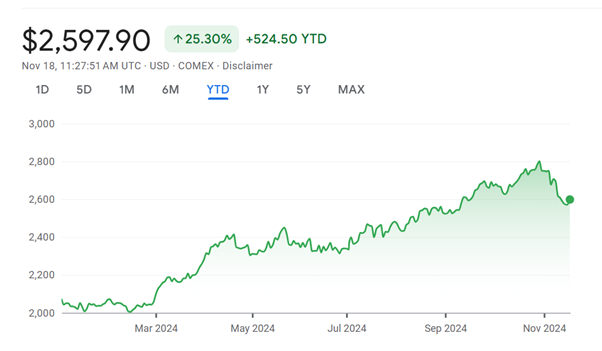
也就是说,从上周五收盘价格到3000的目标价格,还有至少17%左右的空间。除了看黄金到3000以外,高盛还给出了两个潜在更高的可能性:1. 如果特朗普上台以后发生贸易战,增加全球不确定因素。2. 美国财政因为不断增发国债导致可持续性危机。这两种情况都可能导致黄金价格超过3000美元大关。之后再来看看高盛对于美元走强的判断依据:高盛认为,2025年的外汇市场可能以美元的持续强势为主旋律。美国新政府政策组合的调整、美国经济的相对优势以及全球资本的流入,都为美元提供了支撑。因此高盛的投研团队改变之前对于美元看空的判断,反过来,预测美元的强势地位将比此前预期更持久。换句话,就是先啪啪打自己脸。之前的说了不算,重新预测。我估计是他们投研团队换了领导,所以之前的全部推翻,必须按照新领导说的写。当然,按照惯例,毕竟不是给自己亲爹意见,所以高盛还是很社会的留了一手:两头都要押注。他们说,尽管对美元保持乐观,但也指出了一些潜在风险因素:如全球其他经济增长超预期可能重新平衡全球资本流动,削弱美元的吸引力。其次,更大幅度的利率削减也可能对美元构成一定压力。总结一句话就是美元有可能涨,但是也不排除跌。是不是很鸡贼?

所以如果我们看高盛的预测,看完之后都是一个感觉:他到底要表达的是涨,还是跌?但是不论是涨,还是跌,三个月后,他们都可以找出一个更加充分的理由来推翻之前的看法,重新给出“精准而专业“的预测。市场里有个传言说,高盛的判断一般等你看到了,就意味着几乎他们所有的大客户已经建仓完毕,等外面的散户买入,开始接盘了。毕竟,如果你是投了几个亿的超级大客户,不可能和外面拿免费报告的小散在同一时间拿到报告。说了这么多,高盛还是那个高盛,他高概率的反向指标,依然无法动摇其美国第一投行的地位。但是对于我们在金融市场里危险冲浪的小散户而言,千万不要因为某一个机构的规模或头衔大而全信。一定要做到兼听则明,多听,多看,加上自己的思维,才能做到一个相对全面的理性分析。免责声明:GO Markets 分析师或外部发言人提供的信息基于其独立分析或个人经验。所表达的观点或交易风格仅代表其个人;并不代表 GO Markets 的观点或立场。联系方式:墨尔本 03 8658 0603悉尼 02 9188 0418中国地区(中文) 400 120 8537中国地区(英文) +248 4 671 903作者:Mike Huang | GO Markets 销售总监


The last two months, with accelerated selling over the last fortnight, have seen considerable drops in major commodity prices. Oil is at its lowest point since early September, copper likewise and gold futures have dropped almost 8% since the beginning of the month after making record highs. Consequently, on the ASX we have seen the materials sector as a whole drop 6.92%.
Whether a trader or investor in commodity futures or companies in that sector the impact has been significant. In this overview article we discuss the reasons for this and offer some thinking on what may be next for price movement in the three major commodity assets of gold, copper and oil. We will first review factors which influence price before subsequently using these concepts to help understanding of what may be happening, What moves commodity prices – an overview?
In any examination of commodity pricing, it is worth revisiting the broad drivers of market sentiment towards commodities as it will provide context not only for what is happening now but going forward in the short and long term. Although there will be fluctuations due to repositioning from market participants, including of course institutional holding and even government stock levels, we would suggest that there are five key factors: 1. Supply and Demand Dynamics: a.
Factors Affecting Supply: Production Levels: Variations in production due to technological advancements, increasing or decreasing cost of extraction, industrial action, or natural disasters can significantly impact supply. For instance, a major oil producer increasing output can lead to a surplus, driving prices down. Geopolitical Events: Conflicts, trade embargoes, or political instability in key producing regions can disrupt supply chains.
The 2022 Russia-Ukraine conflict, for example, led to disruptions in wheat and energy supplies, causing price spikes. b. Trends in Demand: Economic Growth: Clearly economic growth has a positive impact of demand for commodities as multiple projects are more likely to have funding available both on a micro level with individual businesses and a macro level with national funding potentially more available. Conversely, economic slowdowns reduce demand, leading to price declines.
Organisational Activity: Sectors such as construction and manufacturing drive demand for raw materials. A surge in infrastructure projects can elevate demand for commodities like cement and iron ore. Additionally, of course where increases and cuts in production are controlled by organisations where these exist, OPEC being the obvious example, then this will alter the supply-demand relationship, and so price.
Consumer Behaviour: Actual or potential shifts in consumer preferences, either originating from the consumer (or government poli, such as increased demand for electric vehicles, boost the need for lithium and cobalt. Alternatively, a move towards plant-based diets can affect meat commodity markets. 2. Global Economic Conditions: GDP Growth: Strong GDP growth signals robust economic health, increasing demand for commodities.
In contrast, recessions typically lead to reduced demand and lower prices. Inflation: High inflation can erode purchasing power, decreasing demand. However, commodities like gold often serve as inflation hedges, potentially increasing their demand and price.
Interest Rates: Higher interest rates can strengthen a currency, making commodities priced in that currency more expensive for foreign buyers, potentially reducing demand. 3. Currency Fluctuations: U.S. Dollar Relationship: Many commodities are priced in U.S. dollars.
A stronger dollar makes commodities more expensive for holders of other currencies, potentially reducing global demand and lowering prices. Conversely, a weaker dollar can make commodities cheaper internationally, boosting demand and prices. 4. Geopolitical and Government Events: Wars and Conflicts: Armed conflicts can disrupt production and supply chains, leading to shortages and price increases.
The Middle East conflicts have historically affected oil prices due to supply concerns. Sanctions: Economic sanctions on producing countries can limit supply. For example, sanctions on Iran have impacted global oil supply and prices.
Trade Agreements: New trade deals can open markets, increasing demand and prices, while trade disputes can lead to tariffs, reducing demand and affecting prices. Government policy: Specific changes in government policy, often occurring significantly on change in government as well as midterm will impact of perceived future demand 5. Technical price movements Whichever way you slice it, the impact of actual price movements both current and historical does contribute to what may happen to price subsequently, at least in the short term.
There are two key references that are worthwhile bearing in mind. Support and resistance levels: Previous price action turning points are points at which there has already been significant price action previously, these are used as reference for change in sentiment are places at which future decisions may be made and where many traders place pending orders Market psychological levels: “Round numbers” are often seen, even if largely illogical in terms of actual value of an asset, as being important to market psychology. Multiple of $10, $100, $1000 for example may prove stubborn to breach or significant if there is a move through, often precipitating further trading activity.
Utilization Changes: Developments in renewable energy technologies can reduce demand for fossil fuels, impacting their prices. So, what has happened to pricing and what next? As previously stated, we will focus on the three main commodities of gold, oil and copper and using the broad principles above attempt to unpick what has happening and look into the market “crystal ball to provide a potential outlook.
Gold Gold price breach of a key resistance level after six months of rangebound trading in July signified a major shift in sentiment for the precious metal, and markets saw the interesting and somewhat unusual state where Gold and the USD were moving in the same direction. Gold hit record highs, reaching almost 2800 on 30 th October. An expected profit-taking retracement at the turn of the month soon turned into a reversal, as USD strength continued, and the price dropped through 2700 then 2600 before coming to rest and pause at a 2-month low and what could turn into a support level at 2550 on Friday.
Further selling could see price challenge the next key psychological level at 2500 The recent Gold price decline has been influenced by three key factors: 1. Strengthening U.S. Dollar: The U.S. dollar has appreciated due to robust economic data and perhaps a pause in rate cuts the Federal Reserve and the inflationary pressures of tariffs if implemented by the incoming new US administration in January.
A stronger dollar makes gold more expensive for holders of other currencies, reducing its demand and price. 2. Rising Bond Yields: Increased U.S. Treasury yields have made interest-bearing assets more attractive compared to non-yielding assets like gold, leading investors to shift away from gold. 3.
Reduced Geopolitical Tensions: Although the potential for re-escalation of geopolitical tensions is always present, particularly in the Middle East, appear for now to be decreasing when compared to that of a couple of months ago. Increasing geopolitical tension often results in a flight to safety. There is no doubt this contributed to the previous gold price strength and hence a decrease in tension has resulted in a decrease in price.
Gold outlook: Analysts have mixed views on gold's future trajectory: Potential for Recovery: Some strategists believe that ongoing geopolitical uncertainties and central banks' gold purchases could support a rebound in gold prices. Continued Downward Pressure: Conversely, if the U.S. dollar remains strong and interest rates stay elevated, gold may face further declines. Copper Copper futures hit record highs in May this year of $5.20 and gave away over 25% to not a low in mid-august of $3.19 to officially enter bear market territory.
It has been a wild ride since then with a strong but temporary rally upwards followed by a sharp sell-off over the last couple of weeks, with a price move through the 200ema and pausing at support around $4.05. A breach of $4 and August’s low price could precipitate more selling. Downwards pressure on copper prices is occurring due to three key factors: 1.
Weakening Demand from China: China, the world's largest consumer of copper, has experienced economic challenges, particularly in the real estate sector. Impacts of an increases in US tariffs may slowdown exports and further upset growth. An actual and potentially worsening reduced demand for copper may contribute further to price declines. 2.
Global Economic Uncertainties: Concerns about a global economic slowdown have, and may continue to, dampen industrial activity including construction, decreasing the demand for copper globally. Although, it is fair to categorise the slowdown to be a “soft landing” after potential widespread recession was potentially on the agenda. 3. Supply Surplus: Increased production and rising global inventories have led to a surplus in the copper market, exerting downward pressure on prices.
The demands of copper usage from renewable energy infrastructure projects were one of the reasons why we saw bullish moves in copper through the early part of the year. But with stock level as increased and perhaps a “handbrake’ on the enthusiasm frow governments funding of infrastructure, and notably clear pre-election narrative from the Republicans in the US perhaps the market in pricing a decrease in such compared to that which was expected. Copper Outlook: Generally, analysts appear unoptimistic relating to copper's future trajectory, although as you would expect there are still some contrary views.
Continued Downward Pressure looks likely in the short term with most analysts suggesting at best a maintenance of current range around the $4 level. Of course, USD strength is contributory to potential demand challenges in those transaction in alterative currencies. Many are seeing a test of August lows as likely.
In the longer term, demand may still be intact driven by the global energy decarbonisation and related infrastructure projects, could support a rebound in copper prices. However, the latter may take some time to see moves that push price anywhere near May levels which now seem an increasingly distant memory. Oil Friday’s close price on the WTI futures contract fell slightly below lows last hit the end of October and September respectively at $67.14, and recording a 7% drop for the week.
Any further drop is likely to threaten mid-September lows, and a breach of this would represent a low price not seen for 18 months. Although this could be seen as positive from a reduction in inflation point of view, at this stage the pressure is most certainly downwards. Oil prices have recently declined due to several key factors: 1.
Weaker Demand from China: China, the world's largest crude importer, has shown signs of a sluggish economic recovery, leading to reduced oil consumption. In October, China's oil processing dropped by 4.6% year-over-year, marking the seventh consecutive month of decline. 2. Supply Surplus Expectations: The International Energy Agency (IEA) forecasts an oversupply of oil by 2025, anticipating a supply surplus of 1 million barrels.
This expectation has contributed to downward pressure on current oil prices. 3. Stronger U.S. Dollar: A strengthening U.S. dollar, which reached its highest in a year, has made oil more expensive for holders of other currencies, thereby reducing global demand and contributing to price declines.
Oil outlook: Although there are mixed views on the future trajectory of oil prices, Chinas economic state is critical. This could further impact on a supply surplus, as would the proposed ramp up of US oil production as outlined in Trumps “drill, baby, drill” pre-election promises. OPEC+ production decisions will impact of course, but with production cuts extended into 2025 with little impact in holding up price to date is noteworthy.
Some experts suggest that U.S. oil prices could range between $60 and $70, with a possibility of dropping to $50 in a price war scenario or further evidence of economic slowdown. Further Chinese stimulus measures could support price in the medium term if implemented. In summary As you can see from the above there are common threads” (e.g.
USD strength, relative economic decline), and idiosyncrasies in each of the major commodities. Whether a trader or investor in commodity futures or companies in that sector the impact has and may continue to be significant going forward of some of the issues discussed above. It is therefore your responsibility to not only keep abreast of price movements but changes in some of the key factors outlined in this article.
Of course, GO Markets is always here to help with our extensive updates and live events that may offer insight to help you in your commodity exposure decision making.


热门话题
世界富翁马斯克最近喜事连连,不仅特斯拉股价暴涨140%,而且未来还可能成功跻身政坛,毕竟报恩的特朗普已经任命马斯克领导新一届政府下的“政府效率部”。虽然机构名称是“department”,但不是传统的内阁部门,更像是总统委员会(Presidential commission)。总统委员会是美国政府的外部建议机构,通常由外部专家组成,成立也比较简单,有总统行政令或备忘录即可,这意味着马斯克不用调整其在企业内的任职。马斯克虽然不进内阁,但是有总统的支持,他的权力不会小,市场上对于马斯克的政府工作宣传也很多了,总体来说,他的工作主要是削减联邦政府和支出。之前马斯克曾表示要削减2万亿美元支出,也就是砍掉约1/3的联邦政府支出,如果能成功实施,预计一定程度上可以抵消减税带来的赤字,不过可能会对就业造成影响。

马斯克不仅拥有特斯拉和SpaceX这两家科技巨头,还掌控着社交媒体平台X(前Twitter)。早在2021年,他的一个#bitcoin标签就让比特币在几小时内暴涨了19%;另一条“白银是新的GameStop”的推特甚至在短短几天内拉动银价上涨10%。而当他宣布要把特斯拉私有化时(尽管最终没兑现),TSLA股票当天大涨11%。但是到目前为止,马斯克对于黄金一直没有非常明确的态度。当马斯克全力为SpaceX铺平道路、甚至宣布了激进的火星计划时,他可能不得不关心黄金的价格,毕竟黄金不仅用于造飞船,火星上甚至可能有或可以合成黄金!首先我们来谈谈造飞船与黄金的关系。黄金是火箭和卫星的关键材料,可以帮助避免娇贵的电子设备生锈、腐蚀和损坏。黄金的高导电性可以实现信息在太空中的远距离传输,这对于卫星和空间站来说至关重要。由于黄金可以反射高达99.4% 的光粒子,因此它还可以用于降低太阳热量对航天器的热损耗,这也是为什么太空头盔的面罩上覆盖着一层薄薄的金子的原因,每个头盔的价格大约300 万美元,是地球上最昂贵的头盔之一了。哥伦比亚号航天飞机使用了约41公斤黄金,约合1,446盎司,而 SpaceX 与 NASA 签订了到 2030 年底的 50 亿美元合同,是仅有的与NASA签订商业补给服务(CRS-2)合同的三家公司之一。分析家预计全球航天工业到 2030 年将增长一倍,所以黄金需求将只升不降。
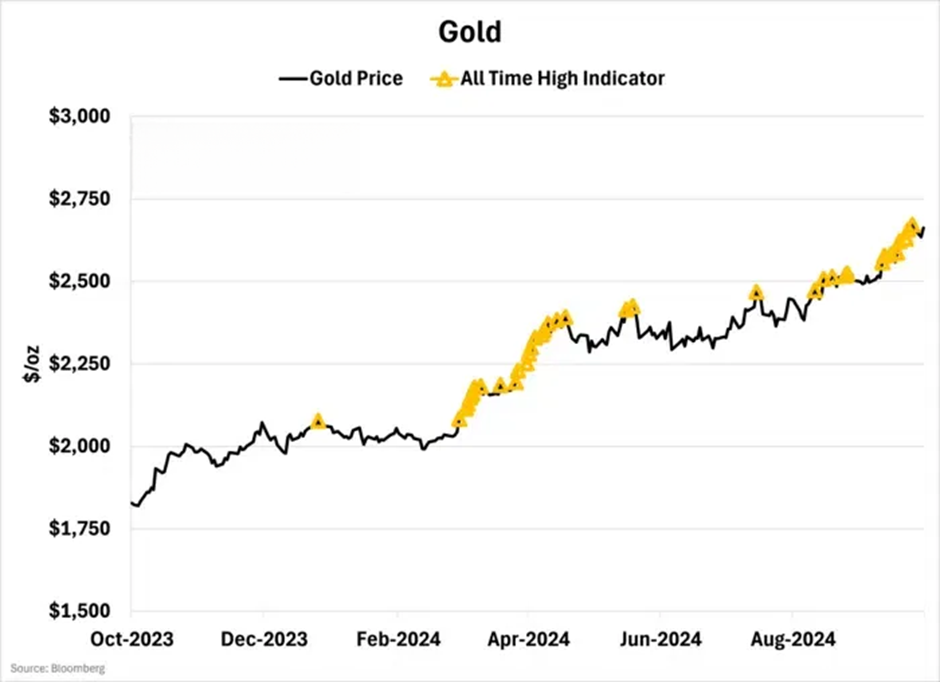
金矿作为一种稀缺品,需求越高,在地球就会越挖越深,就会越挖越少。根据世界黄金协会2024年最新统计,2023年地表黄金库存为212,582吨,大部分集中在1950年以后开采,而2024年三季度全球黄金需求总量(包括场外投资)同比增长5%,当然金价也连创新高,相信美联储降息前上车的朋友们收益不错。那么还有多少黄金可以挖呢?根据美国地质调查局研究,当前已探明储量约59,000吨,这意味着人类已经挖空了约3/4的金矿,结合金矿开采速度和各国金矿消耗速度粗略估计,剩余黄金平均只够挖20年了。

20年后,新增的黄金需求由哪里供给呢?SpaceX的火星计划或许给我们提供了无限可能。火星是一个巨大的红色星球,土壤环境和西澳矿山很接近,如果我们脑洞大开一下,“火星掘金”也不是完全不可能。

(火星地表图片)
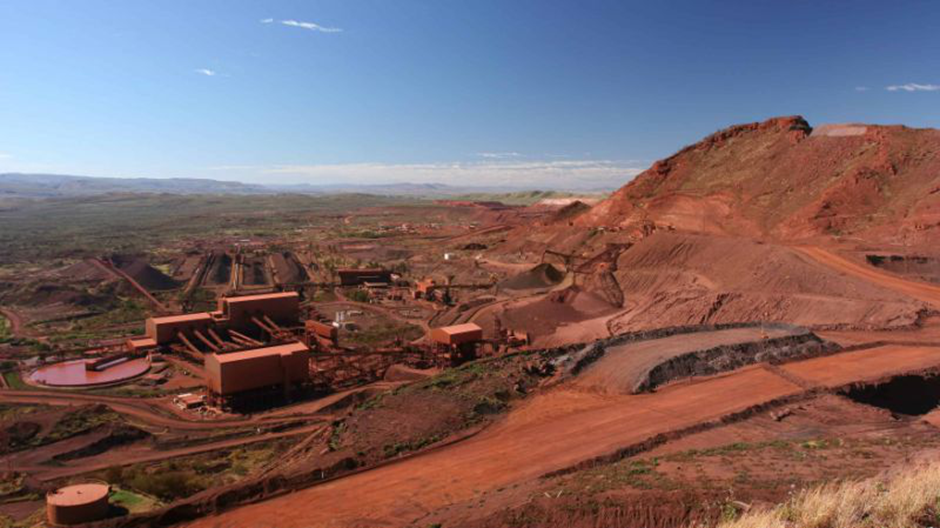
(西澳矿山图片)科学家认为,外太空提供了火星合成黄金的环境条件:超新星爆炸、中子星合并和陨石撞击等宇宙事件会产生重元素,金就是其中之一。根据美国宇航局统计,火星每年遭受280到360 次陨石撞击,可能为金矿的产生提供了契机,而且火星上压力小,相比地球开采难度可能要低一些。

从SpaceX造价来说,马斯克显然希望金价越低越好,这样可以为SpaceX节省成本。但是我们认为,至少在实现火星采矿之前,黄金的需求仍是非常强劲的,至于20年之后会怎么样,就留给科技与科学吧!免责声明:GO Markets 分析师或外部发言人提供的信息基于其独立分析或个人经验。所表达的观点或交易风格仅代表其个人;并不代表 GO Markets 的观点或立场。联系方式:墨尔本 03 8658 0603悉尼 02 9188 0418中国地区(中文) 400 120 8537中国地区(英文) +248 4 671 903作者:Christine Li | GO Markets 墨尔本中文部

